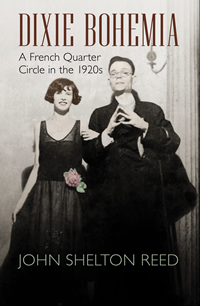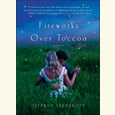La Vie Bohème
John Shelton Reed brings to life a French Quarter arts community in 1920s New Orleans
In 1926 artist William Spratling and his French Quarter roommate, William Faulkner, decided to publish a slim volume of caricatures of their friends in the New Orleans arts community. In Dixie Bohemia, historian John Shelton Reed uses this little book as a snapshot out of time through which to explore the bohemian arts community that thrived in the Vieux Carré of the 1920s.
Spratling and Faulkner called their book—never meant to be more than an amusing lark—Sherwood Anderson and Other Famous Creoles: A Gallery of Contemporary New Orleans, despite the fact that only two of their forty-three subjects (and certainly not Anderson, who grew up in Ohio) were actually of Creole descent and that only a handful could be considered famous. Although the authors’ method of choosing the Famous Creoles was somewhat capricious, these people—who ranged in age from twenty to seventy-six and included fifteen women—collectively represented the most important arts institutions of 1920s New Orleans. These included Tulane University and the Newcomb College Art School, the local newspapers—most prominently the Times-Picayune, The Double Dealer (the first magazine to publish Faulkner and Hemingway), the Arts and Crafts Club, and Le Petit Theatre du Vieux Carré. And they all shared a passion for the art, literature, drama, and historic preservation of their charismatic city.
 Faulkner was twenty-nine years old in 1926 and had arrived in New Orleans the previous year. He shared a fourth-floor attic apartment on St. Peter Street with twenty-five-year-old Spratling, an artist who taught at nearby Tulane University’s School of Architecture. They joined a bohemian community of “artists, writers, journalists, musicians, poseurs, and hangers-on” who may have patterned themselves after social circles in New York’s Greenwich Village or the Left Bank of Paris but whose gifts were displayed against a larger-than-life backdrop of subtropical heat and humidity, diverse musical influences, extravagant architecture (though often in squalid condition), unique cuisine, and alcohol that flowed unabated despite all national efforts to the contrary. Prohibition may have been in full force at the time, but as Tulane philosophy professor James Feibleman observed, “New Orleans did not seem to have heard of it.”
Faulkner was twenty-nine years old in 1926 and had arrived in New Orleans the previous year. He shared a fourth-floor attic apartment on St. Peter Street with twenty-five-year-old Spratling, an artist who taught at nearby Tulane University’s School of Architecture. They joined a bohemian community of “artists, writers, journalists, musicians, poseurs, and hangers-on” who may have patterned themselves after social circles in New York’s Greenwich Village or the Left Bank of Paris but whose gifts were displayed against a larger-than-life backdrop of subtropical heat and humidity, diverse musical influences, extravagant architecture (though often in squalid condition), unique cuisine, and alcohol that flowed unabated despite all national efforts to the contrary. Prohibition may have been in full force at the time, but as Tulane philosophy professor James Feibleman observed, “New Orleans did not seem to have heard of it.”
The most famous of the Famous Creoles was Sherwood Anderson, the fifty-year-old author of Winesburg, Ohio, the critically acclaimed short-story cycle published in 1919. Spratling later referred to him as “the Grand Old Man of the literati in New Orleans at the time.” Anderson’s career was at its peak when he moved to the historic Pontalba Apartments on Jackson Square with his third wife, Elizabeth. Their home was often the social center of the arts scene, and Anderson was generous with his advice and assistance so long as he remained firmly in the spotlight. In 1925 Anderson wrote publisher Horace Liveright that “young Bill Faulkner” was “the one writer here of promise” and indicated his belief that Faulkner was “going to be a real writer.” The two later became estranged, but in 1929 Faulkner dedicated
In the first half of Dixie Bohemia, Reed sets the stage for the Famous Creoles by examining the social conservatism of the region; the pervasive and blind racial inequality of the time, even among the most liberal set; the contributions of gay men, Jews, and the large Sicilian population to the unique atmosphere of life in the Quarter; and the lure of the artistic sub-culture for the wealthy, socially prominent, uptown inhabitants of New Orleans proper, whose money made possible both the artistic experimentation and architectural preservation begun in the 1920s.
 Reed devotes the second half of the book to the Famous Creoles themselves and the stories of their lives—both who they were when Spratling and Faulkner plucked them from obscurity and who they ultimately became. Despite (or perhaps because of) the heady atmosphere of the Quarter, few lasting works of art were produced. “With only a very few exceptions,” Reed explains, “the interest lies less in their artistic achievement than in their larger-than-life personalities and the scene they created.”
Reed devotes the second half of the book to the Famous Creoles themselves and the stories of their lives—both who they were when Spratling and Faulkner plucked them from obscurity and who they ultimately became. Despite (or perhaps because of) the heady atmosphere of the Quarter, few lasting works of art were produced. “With only a very few exceptions,” Reed explains, “the interest lies less in their artistic achievement than in their larger-than-life personalities and the scene they created.”
Reed highlights their achievements, their failures, and their eccentricities—both comic and tragic. Especially poignant is the story of William Ratcliffe Irby, a philanthropist responsible for the protection and renovation of numerous important New Orleans landmarks but who missed being included as a Famous Creole when, a month before the book’s publication, he “visited an undertaker, made arrangements for his funeral, picked out his casket, lay down in it, and put a bullet through his head.” At the opposite end of the spectrum, it is entertaining to read about future literary lion William Faulkner as he walked drunkenly down the street, loudly singing an obscene song, or got banned from a wealthy arts patron’s home after he showed up for an event with bare feet. Years later Faulkner would write about New Orleans: “I don’t come back much because I had more fun there than I ever had and ever will have again anywhere now.”
“Like all living creatures, Bohemias have a natural history, and a life span,” Reed concludes, and by the early 1930s the French Quarter arts community was in decline. As historical preservation became more common, property values began to rise, new businesses opened, and larger numbers of tourists arrived on the scene, making the community less welcoming and less affordable to young artists and writers. Times had simply changed. As Famous Creole Roark Bradford observed, “Too many country boys and girls are coming in to be Bohemians and immorality lacks that calm, professional dignity it held in the corrupt era before 1927.” Reed includes all of the caricatures drawn by William Spratling, as well as dozens of period photographs and seventy pages of notes, making Dixie Bohemia a detailed and varied portrait of a time in American history when a unique arts community thrived in the Vieux Carré of the 1920s.
John Shelton Reed will discuss Dixie Bohemia at Nashville’s Southern Festival of Books on October 14 at 2:30 p.m. in Legislative Plaza Room 12. All festival events are free and open to the public.


